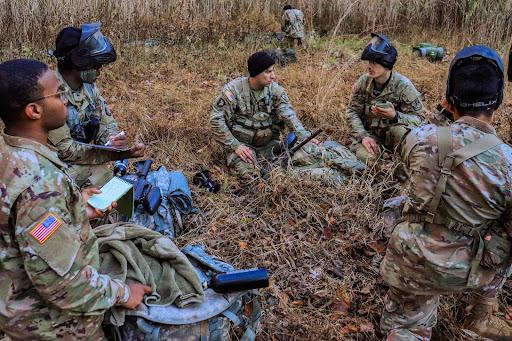In the middle of the woods at the H Steven Blum Military Reservation on a Friday in October, cadets of the Reserve Officers’ Training Corps (ROTC) prepare for their first training exercise. They are completing the exercise in their camo, boots, and backpacks, which weigh about 45 pounds, and carrying rubber weapons to simulate what it is like to be carrying that much extra weight. One of the exercises, referred to as “lanes”, was a three-hour operation where the goal was to find and take down the “enemy”, who is located about 500-600 meters away. This helps the cadets practice land navigation, communication, and formation.
They started off at their “base camp” and slowly made their way through the forest. They moved in three groups of about four to five people. The first group went about 35-45 meters ahead and cleared the area, making sure it was free of enemies and safe to move forward. This was repeated until the last group was signaled to advance their last line. Once they got to the area where the enemy was supposed to be, everyone got quiet. When they spotted the enemy, they got down and started yelling “bang, bang bang!” to simulate firing their weapons.
Cadet Eli Marshall ’23, from Towson University, was responsible for planning Field Trip Exercises (FTX) this semester.
He said, “The goal is to put the cadets in a new environment to test their leadership skills in ways they have not been trained yet. It forces them to think critically in stressful situations and allows them to develop that poise and confidence under pressure.”
Students at Loyola who are in the ROTC are referred to as the Greyhound Battalion. This battalion encompasses undergraduate and graduate students from Loyola University Maryland, Towson University, Notre Dame of Maryland University, and Goucher College. This is one of several exercises they do in the program to prepare for real-life scenarios.
CDT Marshall said, “After you have completed your four years of training in the ROTC and have earned your college degree, you have the option to go into the National Guard, Reserves, or active duty, depending on the year.” This Field Training Exercise lasts three days and two nights and is done twice a year, once each semester. The goal of this is to prepare Cadets for advanced camp, which takes place during their third year.
Cadet Zachary Mazuchowski (Maz) ’23 from Loyola said, “In every exercise, we start off with briefing the two [leaders] of the mission, and from there we watch the information get laid down, and then how they execute the mission.” During the drills, the supervisors, or “lane walkers,” walk the course with the cadets, who acted like they were invisible. The supervisors’ job was to interject only when there was something to be fixed. Second Lieutenant Brian Ricketts, who was a lane walker, said they practice to make sure they get the drill right.
“In this lane, the group will go from their ‘home station’ to the objective, which is where the enemy may be, they will then do actions on the enemy, and then leave the area,” Ricketts said. “We will do this drill many times a day, pretty much until we run out of time.” Cadet Elle White ’23, who was a lane walker, says their goal is to turn the cadets into leaders.
She said, “We are a very personable group who can crack jokes with you and talk with you because we have been in their shoes and know what it is like, and how this can be an incredibly stressful couple of days.”
Cadet Rayyan Saghir ’26, who was participating in his first ever FTX said, “If you had told me I was going to join the ROTC back in high school, I would have never believed it. I have really enjoyed this FTX and how we have been able to apply everything that we have learned in the literature.”
When talking about his future, CDT Saghir said, “Right now I am an SMP cadet. This means I enlisted in the National Guard as a combat medic. I am a biology major right now at Loyola and want to pursue medical school.”
Captain Deshon Sims is the Assistant Professor of Military Science at Loyola. He was deployed in 2012 to Afghanistan in support of Operation Enduring Freedom and is now the executive officer for the ROTC program.
“This is now my third FTX for the Greyhound Battalion,” he said. “These trainings are important because they build up to your training in year three which is CST, Cadet Summer Training, out in Fort Knox, Kentucky.” Capt. Sims said in basic training they teach cadets how to be soldiers, but here they are teaching them to be leaders.
“I have played many different roles within FTX. I have been a lane walker, I have planned the event before and I have also planned the bigger FTX which we host in the spring semester out in Pennsylvania. Here, they are also working exclusively with their peers. So they are all learning the same skill sets, just at different levels.”
At the end of FTX, the goal is that the cadets come out with a sense of confidence and leadership skills that will help them not only in future FTXs but with their careers.
“I love this group. I think we have a very diverse set of people and have been through a lot in the past couple of years, which has definitely made us a stronger and closer group,” CDT White said.
Click here to find out more about the ROTC Greyhound Battalion and how to join.
Featured Image Courtesy of Enrique Muchacho










































































































